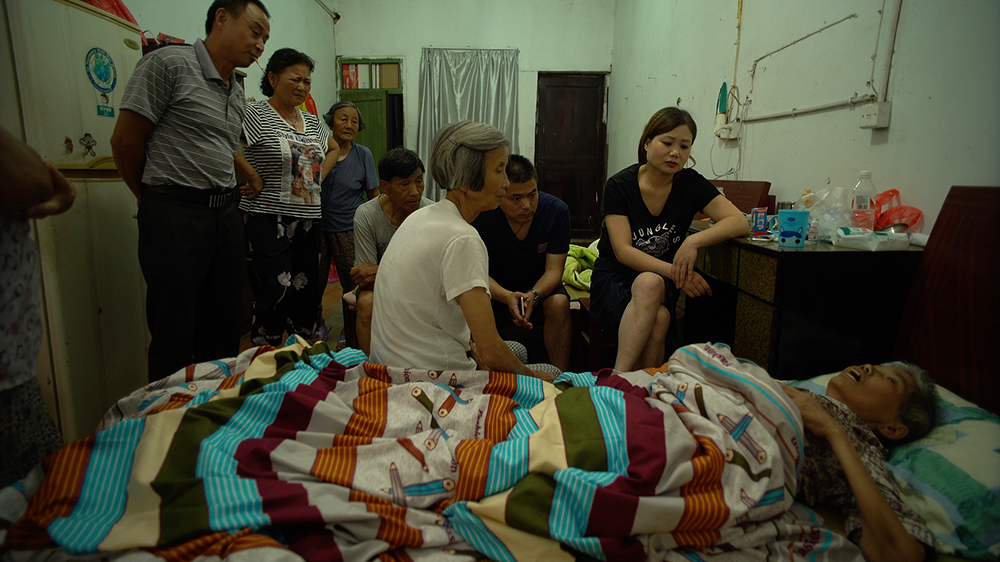Vertical Cinema, Horizontal Cinema

Although it is still young – it’s only fifteen years since West of the Tracks – Wang Bing’s work has already monumental status. It already has its own internal geography, its own secret production techniques. Over the last half dozen years this Chinese director has got into the habit of alternating between long-term projects and much shorter ones. Wang Bing never stops filming. There’s nothing he likes more than being surrounded by people, than gaining their acceptance in order to film what no one else, in China or anywhere, ever shows. He likes to be led by chance encounters, finding in these people he meets the idea and need for a film that will be faster, and not necessarily easier, than the one he was working on at the time. Hence his film Ta’ang, which was released in fall 2016 and followed groups of refugees, especially women, between their camps and the mountains. Hence, too, Fang Xiu Ying [Mrs. Fang]. Wang Bing met her when he was shooting in a village in Southern China. Mrs. Fang is 67 years old. She appears in the first shots, regal in her printed jacket, as if looking the camera up and down. She takes a few steps, mutters two or three words. A few seconds later, here is Mrs. Fang in bed, so thin that we hardly recognize her. She is suffering from Alzheimer’s disease. Her days are numbered. The principle of the film is minimal: it sets out to follow the agony of Mrs. Fang on the bed where she has stopped moving, while members of her family come and go around her. They are busy with their occupations, listening to the radio, competing over taking care of her and debating how much longer she has – “It can go very quickly, but it can also last...” The only relief comes from a few scenes of men outside chatting and of nocturnal fishing – although a shot showing a fish dying on a sidewalk brings us back to the bedroom, with an almost heightened cruelty.
It turns out we have seen Mrs. Fang on her feet for only a few moments. All the rest of the time she is in her bed, and the signs of life that she gives grow fainter and fainter. This is another of the oppositions that organize Wang Bing’s work: upright, lying down. Man entered the history of cinema as a walking figure. At the turn of this century, Wang Bing tirelessly followed the workers – soon to be unemployed, or already so – in the corridors, gangways and rooms of the industrial complex in Tiexi. Without the lightness of the digital, without the endurance of this former art student, there would be no West of the Tracks. Later, but in the same way, Wang Bing walked in the footsteps of the ‘man with no name’.
Ultimate fragments of the possible
On the other hand, he has filmed reclining people in a way that is just as tireless and perhaps even more singular. They are the prisoners in the camp of The Ditch. They are the patients of ’Till Madness Do Us Part. It is the idle boy in Father and Sons, also shown at Documenta and not released in France. These are lives revolving around a layer of misfortune where people eat, write, pray, suffer and invite one or several friends under the duvet. And now, Mrs. Fang, sometimes filmed so close up that her jaw seems to be touching the lens and its muted groans to be buttonholing us; sometimes, on the contrary, seen from the other end of the room, a slender silhouette disappearing silently under the blanket, while those around her busy themselves noisily.
Vertical cinema, films that walk. Horizontal cinema, films that are recumbent. Between them is a time outside time, the same duration alien to the laws of work, of reason and of health. How, and until when, can a life be extended once it seems to have left itself behind? What virtual actions remain latent within what appears to be the most complete inaction? From indefatigable walking to the fatigue of the recumbent, the spectacular reversal of postures is also accompanied by a shared perseverance: Wang Bing’s gesture consists in disengaging from the core of exhaustion the ultimate fragments of the possible.
Put back in the context of Documenta 14, the presentation of Mrs. Fang and the division between kinds of recumbence and kinds of sleeping takes on another meaning. Before the screening, Wang Bing apologized for the poor technical quality of what the audience was about to see, which in his view was inferior to what the art world is used to. The film was shown at the Kino Gloria, but it is not sure that Wang Bing wants Mrs. Fang to be shown theatrically. Not sure that in his eyes it is actually a film, in the strict sense.
Art at the bedside of cinema?
Might the border between cinema and art be coterminous with that between walking and recumbence? It is tempting to think so. A year ago another chamber movie was released about a supine figure that some claimed would have been better off in a gallery. This was La mort de Louis XIV1 and its director, the Catalan Albert Serra, was also honoured by Documenta, the last one, where he showed Three Little Pigs, based on the words of three historic Germans: Johan Wolfgang Goethe, Adolf Hitler and Rainer Werner Fassbinder.
The difference between Mrs. Fang and Louis XIV are obvious: where one is surrounded by pomp, the other is mired in poverty (Mrs. Fang’s family can’t afford the treatment and so prefers to splurge its savings on a funeral blow-out), and the melting solicitousness of the king’s flunkeys are worlds away from the brusqueness of the Fangs, just as the whispering of courtiers clashes with the shouting of the Chinese. And yet the set-up is the same. It evokes an assembly of spectators gathered around a work, a painting, going deep into compliments and interpretations. The score is not new. At the cinema, it is the images that move, not the spectators. In a museum or gallery, the opposite is the case: the images do not move, but the spectators and the visitors do. Despite the gulf between them, should not these pieces by Wang Bing and Albert Serra both be read as allegories, that of art hovering, like a vulture or a disciple, at cinema’s bedside table? That’s a question for the long grass, but meanwhile I would stress another resemblance. Serra is interested in the great mythological figures of Western history, both literary and historical: Don Quixote, the Wise Men, Dracula, Casanova, Louis XIV. With Wang Bing it’s the opposite: he does not film ‘great names’ but the ‘nameless’, those ignored by the radar of History. And yet both bodies of work inhabit a shared time, eked out from beyond or within exhaustion: the exhaustion of myths, of productive forces, of the division between work and worklessness. And it is therefore not absurd to argue that their respective approaches – their refusal to walk, their way of making their bed – could also escape the habitual cartographies of art and cinema.

- 1See artpress 433 (May 2016).
Originally published as ‘Wang Bing à Cassel’ in artpress 447 (September 2017).
With thanks to Emmanuel Burdeau
Images (1) and (2) from Mrs. Fang (Wang Bing, 2017)

